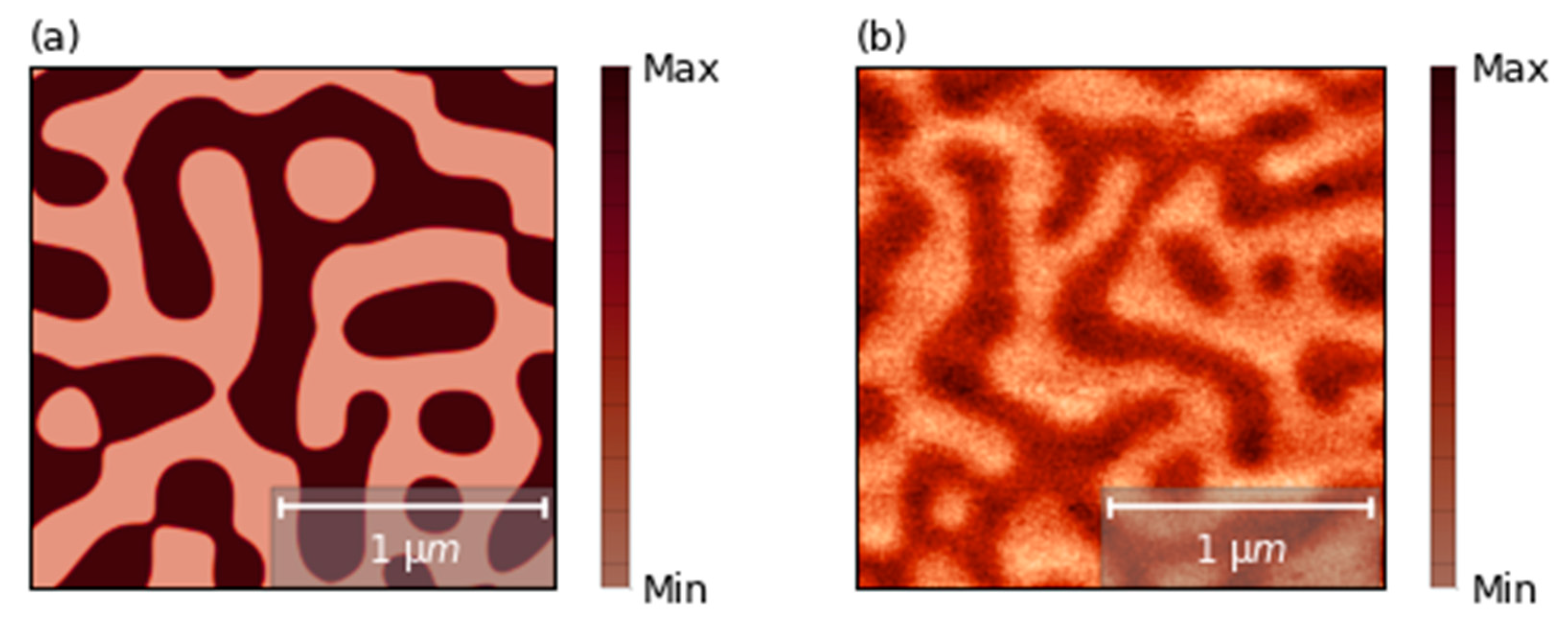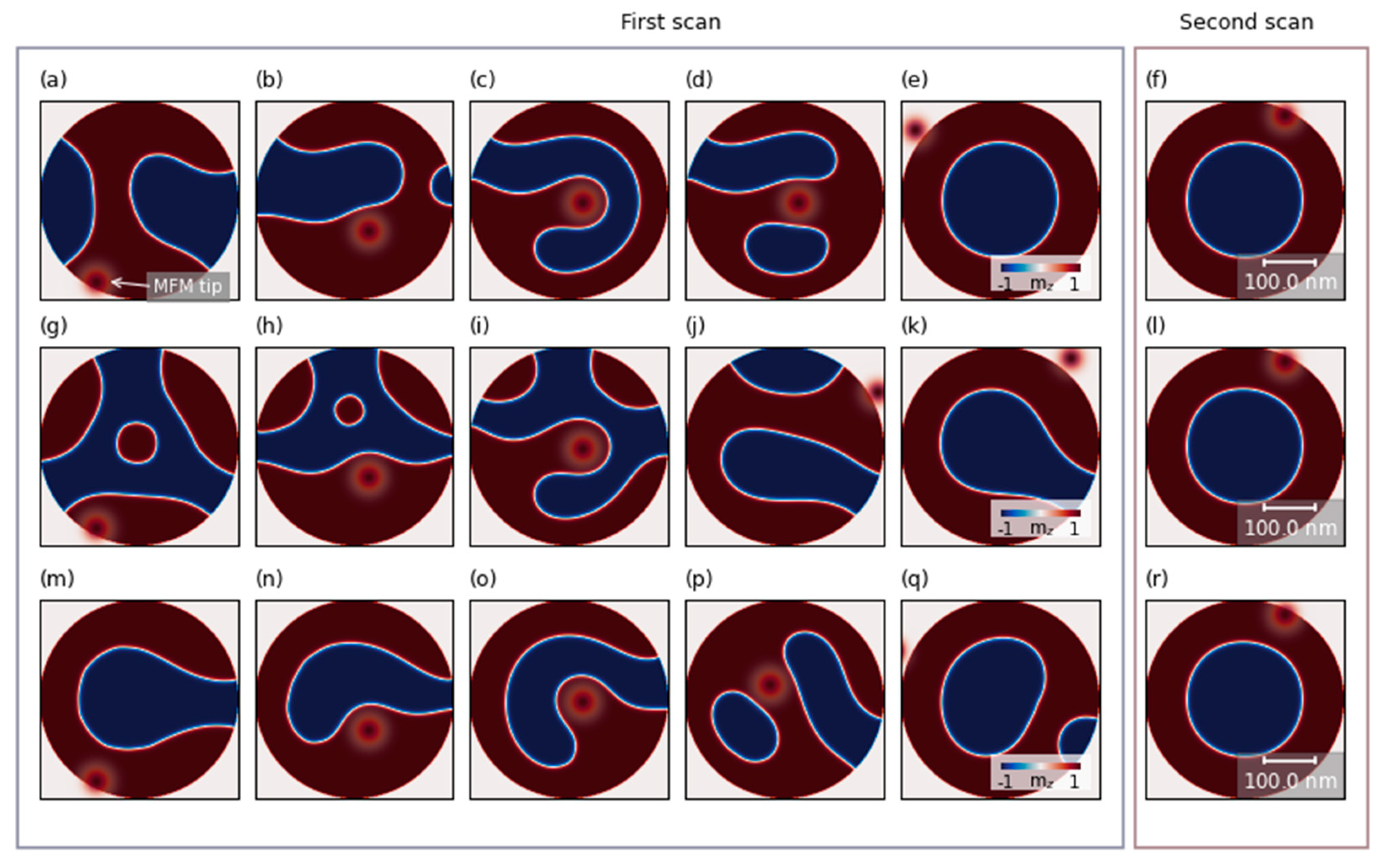Skyrmion Formation in Nanodisks Using Magnetic Force Microscopy Tip
Abstract
:1. Introduction
2. Materials and Methods
2.1. Fabrication
2.2. Measurements
2.3. Micromagnetic Simulations
3. Results and Discussion
3.1. Inducing Single-Domain State
3.2. Inducing Skyrmion
4. Conclusions
Author Contributions
Funding
Data Availability Statement
Conflicts of Interest
References
- Srivastava, T.; Schott, M.; Juge, R.; Křižáková, V.; Belmeguenai, M.; Roussigné, Y.; Bernand-Mantel, A.; Ranno, L.; Pizzini, S.; Chérif, S.-M.; et al. Large-Voltage Tuning of Dzyaloshinskii–Moriya Interactions: A Route toward Dynamic Control of Skyrmion Chirality. Nano Lett. 2018, 18, 4871–4877. [Google Scholar] [CrossRef]
- Je, S.-G.; Vallobra, P.; Srivastava, T.; Rojas-Sánchez, J.-C.; Pham, T.H.; Hehn, M.; Malinowski, G.; Baraduc, C.; Auffret, S.; Gaudin, G.; et al. Creation of Magnetic Skyrmion Bubble Lattices by Ultrafast Laser in Ultrathin Films. Nano Lett. 2018, 18, 7362–7371. [Google Scholar] [CrossRef]
- Maccariello, D.; Legrand, W.; Reyren, N.; Garcia, K.; Bouzehouane, K.; Collin, S.; Cros, V.; Fert, A. Electrical detection of single magnetic skyrmions in metallic multilayers at room temperature. Nat. Nanotechnol. 2018, 13, 233–237. [Google Scholar] [CrossRef] [PubMed] [Green Version]
- Ma, F.; Zhou, Y.; Braun, H.B.; Lew, W.S. Skyrmion-Based Dynamic Magnonic Crystal. Nano Lett. 2015, 15, 4029–4036. [Google Scholar] [CrossRef]
- Fert, A.; Reyren, N.; Cros, V. Magnetic skyrmions: Advances in physics and potential applications. Nat. Rev. Mater. 2017, 2, 31. [Google Scholar] [CrossRef]
- Romming, N.; Hanneken, C.; Menzel, M.; Bickel, J.E.; Wolter, B.; von Bergmann, K.; Kubetzka, A.; Wiesendanger, R. Writing and Deleting Single Magnetic Skyrmions. Science 2013, 341, 636–639. [Google Scholar] [CrossRef] [Green Version]
- Büttner, F.; Lemesh, I.; Beach, G.S.D. Theory of isolated magnetic skyrmions: From fundamentals to room temperature applications. Sci. Rep. 2018, 8, 1–12. [Google Scholar] [CrossRef] [PubMed] [Green Version]
- Zelent, M.; Tóbik, J.; Krawczyk, M.; Guslienko, K.Y.; Mruczkiewicz, M. Bi-Stability of Magnetic Skyrmions in Ultrathin Multilayer Nanodots Induced by Magnetostatic Interaction. Phys. Status Solidi (RRL) Rapid Res. Lett. 2017, 11, 1700259. [Google Scholar] [CrossRef] [Green Version]
- Rohart, S.; Thiaville, A. Skyrmion confinement in ultrathin film nanostructures in the presence of Dzyaloshinskii-Moriya interaction. Phys. Rev. B 2013, 88, 184422. [Google Scholar] [CrossRef] [Green Version]
- Zeissler, K.; Mruczkiewicz, M.; Finizio, S.; Raabe, J.; Shepley, P.; Sadovnikov, A.V.; Nikitov, S.A.; Fallon, K.; McFadzean, S.; Mcvitie, S.; et al. Pinning and hysteresis in the field dependent diameter evolution of skyrmions in Pt/Co/Ir superlattice stacks. Sci. Rep. 2017, 7, 15125. [Google Scholar] [CrossRef] [Green Version]
- Karakaş, V.; Gokce, A.; Habiboglu, A.T.; Arpaci, S.; Ozbozduman, K.; Cinar, I.; Yanik, C.; Tomasello, R.; Tacchi, S.; Siracusano, G.; et al. Observation of Magnetic Radial Vortex Nucleation in a Multilayer Stack with Tunable Anisotropy. Sci. Rep. 2018, 8, 7180. [Google Scholar] [CrossRef] [Green Version]
- Boulle, O.; Vogel, J.; Yang, H.; Pizzini, S.; Chaves, D.D.S.; Locatelli, A.; Menteş, T.O.; Sala, A.; Buda-Prejbeanu, L.D.; Klein, O.; et al. Room-temperature chiral magnetic skyrmions in ultrathin magnetic nanostructures. Nat. Nanotechnol. 2016, 11, 449–454. [Google Scholar] [CrossRef] [Green Version]
- Saha, S.; Zelent, M.; Finizio, S.; Mruczkiewicz, M.; Tacchi, S.; Suszka, A.K.; Wintz, S.; Bingham, N.S.; Raabe, J.; Krawczyk, M.; et al. Formation of Néel-type skyrmions in an antidot lattice with perpendicular magnetic anisotropy. Phys. Rev. B 2019, 100, 144435. [Google Scholar] [CrossRef] [Green Version]
- Casiraghi, A.; Corte-León, H.; Vafaee, M.; Garcia-Sanchez, F.; Durin, G.; Pasquale, M.; Jakob, G.; Kläui, M.; Kazakova, O. Individual skyrmion manipulation by local magnetic field gradients. Commun. Phys. 2019, 2, 1–9. [Google Scholar] [CrossRef]
- Qin, Z.; Jin, C.; Xie, H.; Li, X.; Wang, Y.; Cao, J.; Liu, Q. Size-tunable skyrmion bubbles in Ta/CoFeB/MgO multilayers. J. Phys. D Appl. Phys. 2018, 51, 425001. [Google Scholar] [CrossRef]
- Temiryazev, A.G.; Temiryazeva, M.P.; Zdoroveyshchev, A.V.; Vikhrova, O.V.; Dorokhin, M.V.; Demina, P.B.; Kudrin, A.V. Formation of a Domain Structure in Multilayer CoPt Films by Magnetic Probe of an Atomic Force Microscope. Phys. Solid State 2018, 60, 2200–2206. [Google Scholar] [CrossRef]
- Zhang, S.; Zhang, J.; Zhang, Q.; Barton, C.; Neu, V.; Zhao, Y.; Hou, Z.; Wen, Y.; Gong, C.; Kazakova, O.; et al. Direct writing of room temperature and zero field skyrmion lattices by a scanning local magnetic field. Appl. Phys. Lett. 2018, 112, 132405. [Google Scholar] [CrossRef] [Green Version]
- Ognev, A.V.; Kolesnikov, A.G.; Kim, Y.J.; Cha, I.H.; Sadovnikov, A.V.; Nikitov, S.A.; Soldatov, I.V.; Talapatra, A.; Mohanty, J.; Mruczkiewicz, M.; et al. Magnetic Direct-Write Skyrmion Nanolithography. ACS Nano 2020, 14, 14960–14970. [Google Scholar] [CrossRef] [PubMed]
- Mironov, V.L.; Gorev, R.V.; Ermolaeva, O.L.; Gusev, N.S.; Petrov, Y. Impact of the Field of a Magnetic Force Microscope Probe on the Skyrmion State in a Modified Co/Pt Film with Perpendicular Anisotropy. Phys. Solid State 2019, 61, 1594–1598. [Google Scholar] [CrossRef]
- Berganza, E.; Jaafar, M.; Fernández-Roldán, J.Á.; Goiriena-Goikoetxea, M.; Pablo-Navarro, J.; García-Arribas, A.; Guslienko, K.; Magén, C.; De Teresa, J.M.; Chubykalo-Fesenko, O.; et al. Half-hedgehog spin textures in sub-100 nm soft magnetic nanodots. Nanoscale 2020, 12, 18646. [Google Scholar] [CrossRef] [PubMed]
- Di, K.; Zhang, V.L.; Lim, H.S.; Ng, S.C.; Kuok, M.H.; Yu, J.; Yoon, J.; Qiu, X.; Yang, H. Direct Observation of the Dzyaloshinskii-Moriya Interaction in a Pt/Co/Ni Film. Phys. Rev. Lett. 2015, 114, 047201. [Google Scholar] [CrossRef] [PubMed]
- Samardak, A.; Kolesnikov, A.; Stebliy, M.; Chebotkevich, L.; Sadovnikov, A.; Nikitov, S.; Talapatra, A.; Mohanty, J.; Ognev, A. Enhanced interfacial Dzyaloshinskii-Moriya interaction and isolated skyrmions in the inversion-symmetry-broken Ru/Co/W/Ru films. Appl. Phys. Lett. 2018, 112, 192406. [Google Scholar] [CrossRef]
- Sadovnikov, A.V.; Beginin, E.N.; Sheshukova, S.E.; Sharaevskii, Y.P.; Stognij, A.I.; Novitski, N.N.; Sakharov, V.K.; Khivintsev, Y.V.; Nikitov, S.A. Route toward semiconductor magnonics: Light-induced spin-wave nonreciprocity in a YIG/GaAs structure. Phys. Rev. B 2019, 99, 054424. [Google Scholar] [CrossRef]
- Precner, M.; Fedor, J.; Tóbik, J.; Šoltýs, J.; Cambel, V. High Resolution Tips for Switching Magnetization MFM. Acta Phys. Pol. A 2014, 126, 386–387. [Google Scholar] [CrossRef]
- Lepadatu, S. Boris computational spintronics—High performance multi-mesh magnetic and spin transport modeling software. J. Appl. Phys. 2020, 128, 243902. [Google Scholar] [CrossRef]
- Lepadatu, S. Efficient computation of demagnetizing fields for magnetic multilayers using multilayered convolution. J. Appl. Phys. 2019, 126, 103903. [Google Scholar] [CrossRef]
- Yamanouchi, M.; Jander, A.; Dhagat, P.; Ikeda, S.; Matsukura, F.; Ohno, H. Domain structure in CoFeB thin films with perpendicular magnetic anisotropy. IEEE Magn. Lett. 2011, 2, 3000304. [Google Scholar] [CrossRef] [Green Version]
- Metaxas, P.J.; Jamet, J.P.; Mougin, A.; Cormier, M.; Ferré, J.; Baltz, V.; Rodmacq, B.; Dieny, B.; Stamps, R.L. Creep and Flow Regimes of Magnetic Domain-Wall Motion in Ultrathin Pt/Co/Pt Films with Perpendicular Anisotropy. Phys. Rev. Lett. 2007, 99, 217208. [Google Scholar] [CrossRef] [PubMed] [Green Version]
- Mironov, V.L.; Gribkov, B.A.; Vdovichev, S.N.; Gusev, S.A.; Fraerman, A.A.; Ermolaeva, O.L.; Shubin, A.B.; Alexeev, A.M.; Zhdan, P.A.; Binns, C. Magnetic force microscope tip-induced remagnetization of CoPt nanodisks with perpendicular anisotropy. J. Appl. Phys. 2009, 106, 53911. [Google Scholar] [CrossRef] [Green Version]
- Gorchon, J.; Bustingorry, S.; Ferré, J.; Jeudy, V.; Kolton, A.B.; Giamarchi, T. Pinning-Dependent Field-Driven Domain Wall Dynamics and Thermal Scaling in an Ultrathin Pt/Co/Pt Magnetic Film. Phys. Rev. Lett. 2014, 113, 027205. [Google Scholar] [CrossRef] [Green Version]
- Bryan, M.T.; Atkinson, D.; Cowburn, R.P. Edge roughness and coercivity in magnetic nanostructures. J. Phys. Conf. Ser. 2005, 17, 40–44. [Google Scholar] [CrossRef]
- Pütter, S.; Mikuszeit, N.; Vedmedenko, E.Y.; Oepen, H.P. The effect of tilted edges on the shape anisotropy and stray field coupling of uniformly mag-netized rectangular elements. J. Appl. Phys. 2009, 106. [Google Scholar] [CrossRef]
- Maranville, B.B.; McMichael, R.D.; Abraham, D.W. Variation of thin film edge magnetic properties with patterning process conditions in Ni80Fe20 stripes. Appl. Phys. Lett. 2007, 90, 232504. [Google Scholar] [CrossRef]
- Matsuura, H.; Okushi, H. Schottky barrier junctions of hydrogenated amorphous silicon-germanium alloys. J. Appl. Phys. 1987, 62, 2871–2879. [Google Scholar] [CrossRef]
- Guo, F.; Belova, L.; McMichael, R.D. Spectroscopy and Imaging of Edge Modes in Permalloy Nanodisks. Phys. Rev. Lett. 2013, 110, 017601. [Google Scholar] [CrossRef] [PubMed] [Green Version]
- Vetrova, I.V.; Zelent, M.; Šoltýs, J.; Gubanov, V.A.; Sadovnikov, A.V.; Šcepka, T.; Dérer, J.; Stoklas, R.; Cambel, V.; Mruczkiewicz, M. Investigation of self-nucleated skyrmion states in the ferromagnetic/nonmagnetic multilayer dot. Appl. Phys. Lett. 2021, 118, 212409. [Google Scholar] [CrossRef]
- Lin, S.-Z. Edge instability in a chiral stripe domain under an electric current and skyrmion generation. Phys. Rev. B 2016, 94, 020402. [Google Scholar] [CrossRef] [Green Version]





| Sample | ΔfSW, GHz | D, mJ/m2 |
|---|---|---|
| (Pt(1.5)/Co(1.2)/Au(1.5))×4 | 1.12 ± 0.1 | 1.0 ± 0.1 |
| (Pt(1.5)/Co(1.2)/Au(1.5))×5 | 1.16 ± 0.1 | 1.04 ± 0.1 |
| (Pt(1.5)/Co(1.2)/Au(1.5))×6 | 0.89 ± 0.1 | 0.79 ± 0.1 |
| (Pt(1.5)/Co(1.2)/Au(1.5))×7 | 1.12 ± 0.1 | 1.0 ± 0.1 |
Publisher’s Note: MDPI stays neutral with regard to jurisdictional claims in published maps and institutional affiliations. |
© 2021 by the authors. Licensee MDPI, Basel, Switzerland. This article is an open access article distributed under the terms and conditions of the Creative Commons Attribution (CC BY) license (https://creativecommons.org/licenses/by/4.0/).
Share and Cite
Zelent, M.; Vetrova, I.V.; Šoltýs, J.; Li, X.; Zhou, Y.; Gubanov, V.A.; Sadovnikov, A.V.; Šcepka, T.; Dérer, J.; Stoklas, R.; et al. Skyrmion Formation in Nanodisks Using Magnetic Force Microscopy Tip. Nanomaterials 2021, 11, 2627. https://doi.org/10.3390/nano11102627
Zelent M, Vetrova IV, Šoltýs J, Li X, Zhou Y, Gubanov VA, Sadovnikov AV, Šcepka T, Dérer J, Stoklas R, et al. Skyrmion Formation in Nanodisks Using Magnetic Force Microscopy Tip. Nanomaterials. 2021; 11(10):2627. https://doi.org/10.3390/nano11102627
Chicago/Turabian StyleZelent, Mateusz, Iuliia V. Vetrova, Jan Šoltýs, Xiaoguang Li, Yan Zhou, Vladislav A. Gubanov, Alexandr V. Sadovnikov, Tomas Šcepka, Jan Dérer, Roman Stoklas, and et al. 2021. "Skyrmion Formation in Nanodisks Using Magnetic Force Microscopy Tip" Nanomaterials 11, no. 10: 2627. https://doi.org/10.3390/nano11102627






